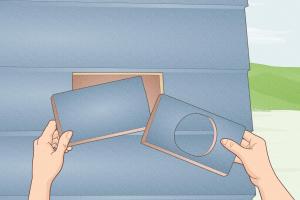Ultimate Guide: How to Properly Cover a Dryer Vent Hole

-
Quick Links:
- Introduction
- Why Cover a Dryer Vent Hole?
- Materials Needed
- Step-by-Step Guide to Covering a Dryer Vent Hole
- Case Studies & Examples
- Expert Insights
- FAQs
Introduction
Dryer vent holes are a necessary part of your laundry setup, allowing moisture and lint to escape from your dryer. However, there are times when these holes may need to be covered, such as when you relocate your dryer or during seasonal changes. This guide will provide you with everything you need to know about covering a dryer vent hole effectively and safely.
Why Cover a Dryer Vent Hole?
Covering a dryer vent hole can serve multiple purposes:
- Energy Efficiency: Prevents drafts and loss of heated or cooled air.
- Safety: Reduces the risk of pests entering your home.
- Maintenance: Helps in keeping your home clean and reducing lint build-up.
- Cosmetic Reasons: Improves the appearance of your home's exterior.
Materials Needed
Before starting the project, gather the following materials:
- Dryer vent cover or plate
- Sealant or caulk
- Power drill
- Screws
- Measuring tape
- Utility knife
- Safety goggles
- Dust mask
Step-by-Step Guide to Covering a Dryer Vent Hole
Follow these detailed steps to cover your dryer vent hole correctly:
Step 1: Measure the Hole
Use a measuring tape to determine the dimensions of the dryer vent hole. This will ensure that you purchase the right size cover.
Step 2: Choose the Right Cover
Select a dryer vent cover that fits your measurements. You can choose between a flat cover, a magnetic cover, or a specially designed vent cap.
Step 3: Prepare the Area
Clean the area around the vent hole. Remove any debris or old caulking to ensure a smooth application.
Step 4: Apply Sealant
Use sealant or caulk around the edges of the vent hole. This will help create a tight seal, preventing drafts.
Step 5: Install the Cover
Align the cover with the hole and secure it using screws. Ensure that it is firmly attached to avoid any gaps.
Step 6: Test for Air Leaks
After installation, check for any air leaks by holding your hand near the cover. If you feel air escaping, reapply sealant as needed.
Step 7: Maintain the Cover
Regularly inspect the cover for wear and tear. Replace it if you notice any damage.
Case Studies & Examples
Here are a few examples of homeowners who have successfully covered their dryer vent holes:
- Case Study 1: A homeowner in Colorado replaced their old vent cover with a magnetic one during winter, which significantly reduced energy costs.
- Case Study 2: After relocating their dryer, a family in Texas used a flat cover and noticed a decrease in pest problems.
Expert Insights
According to HVAC professionals, a well-covered dryer vent hole can prevent moisture accumulation, which is essential for maintaining indoor air quality. Regular maintenance and covering your vent can also prolong the life of your dryer.
FAQs
Here are some common questions related to covering a dryer vent hole:
- What is the best material for covering a dryer vent hole?
Metal or durable plastic covers are recommended for longevity. - Can I use tape to cover my dryer vent hole?
Tape is not recommended as it may not create a secure seal. - How often should I check my dryer vent cover?
Check it at least once a year for any signs of damage. - Is it necessary to cover a dryer vent hole in winter?
Yes, it helps prevent cold drafts and improves energy efficiency. - Can I remove the cover in summer?
Yes, but ensure it is securely reattached during colder months. - What tools do I need for this project?
A power drill, measuring tape, and sealant are essential. - How do I prevent pests from entering through the vent hole?
A tight cover with sealant will help deter pests. - Should I hire a professional for this task?
It can be a DIY project, but consulting a professional is advisable for safety. - What if my dryer vent hole is larger than standard covers?
Consider using a custom cover or seeking professional advice. - Can I paint the cover to match my home?
Yes, as long as you use exterior-grade paint.